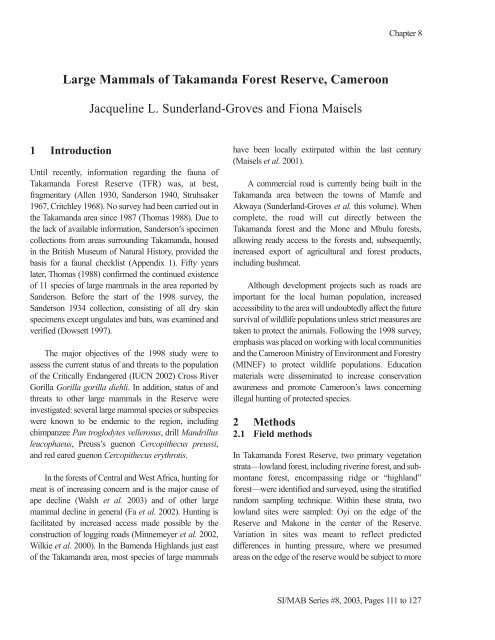Fisheries in the Southern Border Zone of Takamanda - Impact ...
Fisheries in the Southern Border Zone of Takamanda - Impact ...
Fisheries in the Southern Border Zone of Takamanda - Impact ...
You also want an ePaper? Increase the reach of your titles
YUMPU automatically turns print PDFs into web optimized ePapers that Google loves.
Large Mammals <strong>of</strong> <strong>Takamanda</strong> Forest Reserve, Cameroon<br />
1 Introduction<br />
Jacquel<strong>in</strong>e L. Sunderland-Groves and Fiona Maisels<br />
Until recently, <strong>in</strong>formation regard<strong>in</strong>g <strong>the</strong> fauna <strong>of</strong><br />
<strong>Takamanda</strong> Forest Reserve (TFR) was, at best,<br />
fragmentary (Allen 1930, Sanderson 1940, Struhsaker<br />
1967, Critchley 1968). No survey had been carried out <strong>in</strong><br />
<strong>the</strong> <strong>Takamanda</strong> area s<strong>in</strong>ce 1987 (Thomas 1988). Due to<br />
<strong>the</strong> lack <strong>of</strong> available <strong>in</strong>formation, Sanderson’s specimen<br />
collections from areas surround<strong>in</strong>g <strong>Takamanda</strong>, housed<br />
<strong>in</strong> <strong>the</strong> British Museum <strong>of</strong> Natural History, provided <strong>the</strong><br />
basis for a faunal checklist (Appendix 1). Fifty years<br />
later, Thomas (1988) confirmed <strong>the</strong> cont<strong>in</strong>ued existence<br />
<strong>of</strong> 11 species <strong>of</strong> large mammals <strong>in</strong> <strong>the</strong> area reported by<br />
Sanderson. Before <strong>the</strong> start <strong>of</strong> <strong>the</strong> 1998 survey, <strong>the</strong><br />
Sanderson 1934 collection, consist<strong>in</strong>g <strong>of</strong> all dry sk<strong>in</strong><br />
specimens except ungulates and bats, was exam<strong>in</strong>ed and<br />
verified (Dowsett 1997).<br />
The major objectives <strong>of</strong> <strong>the</strong> 1998 study were to<br />
assess <strong>the</strong> current status <strong>of</strong> and threats to <strong>the</strong> population<br />
<strong>of</strong> <strong>the</strong> Critically Endangered (IUCN 2002) Cross River<br />
Gorilla Gorilla gorilla diehli. In addition, status <strong>of</strong> and<br />
threats to o<strong>the</strong>r large mammals <strong>in</strong> <strong>the</strong> Reserve were<br />
<strong>in</strong>vestigated: several large mammal species or subspecies<br />
were known to be endemic to <strong>the</strong> region, <strong>in</strong>clud<strong>in</strong>g<br />
chimpanzee Pan troglodytes vellerosus, drill Mandrillus<br />
leucophaeus, Preuss’s guenon Cercopi<strong>the</strong>cus preussi,<br />
and red eared guenon Cercopi<strong>the</strong>cus erythrotis.<br />
In <strong>the</strong> forests <strong>of</strong> Central and West Africa, hunt<strong>in</strong>g for<br />
meat is <strong>of</strong> <strong>in</strong>creas<strong>in</strong>g concern and is <strong>the</strong> major cause <strong>of</strong><br />
ape decl<strong>in</strong>e (Walsh et al. 2003) and <strong>of</strong> o<strong>the</strong>r large<br />
mammal decl<strong>in</strong>e <strong>in</strong> general (Fa et al. 2002). Hunt<strong>in</strong>g is<br />
facilitated by <strong>in</strong>creased access made possible by <strong>the</strong><br />
construction <strong>of</strong> logg<strong>in</strong>g roads (M<strong>in</strong>nemeyer et al. 2002,<br />
Wilkie et al. 2000). In <strong>the</strong> Bamenda Highlands just east<br />
<strong>of</strong> <strong>the</strong> <strong>Takamanda</strong> area, most species <strong>of</strong> large mammals<br />
have been locally extirpated with<strong>in</strong> <strong>the</strong> last century<br />
(Maisels et al. 2001).<br />
A commercial road is currently be<strong>in</strong>g built <strong>in</strong> <strong>the</strong><br />
<strong>Takamanda</strong> area between <strong>the</strong> towns <strong>of</strong> Mamfe and<br />
Akwaya (Sunderland-Groves et al. this volume). When<br />
complete, <strong>the</strong> road will cut directly between <strong>the</strong><br />
<strong>Takamanda</strong> forest and <strong>the</strong> Mone and Mbulu forests,<br />
allow<strong>in</strong>g ready access to <strong>the</strong> forests and, subsequently,<br />
<strong>in</strong>creased export <strong>of</strong> agricultural and forest products,<br />
<strong>in</strong>clud<strong>in</strong>g bushmeat.<br />
Although development projects such as roads are<br />
important for <strong>the</strong> local human population, <strong>in</strong>creased<br />
accessibility to <strong>the</strong> area will undoubtedly affect <strong>the</strong> future<br />
survival <strong>of</strong> wildlife populations unless strict measures are<br />
taken to protect <strong>the</strong> animals. Follow<strong>in</strong>g <strong>the</strong> 1998 survey,<br />
emphasis was placed on work<strong>in</strong>g with local communities<br />
and <strong>the</strong> Cameroon M<strong>in</strong>istry <strong>of</strong> Environment and Forestry<br />
(MINEF) to protect wildlife populations. Education<br />
materials were dissem<strong>in</strong>ated to <strong>in</strong>crease conservation<br />
awareness and promote Cameroon’s laws concern<strong>in</strong>g<br />
illegal hunt<strong>in</strong>g <strong>of</strong> protected species.<br />
2 Methods<br />
2.1 Field methods<br />
Chapter 8<br />
In <strong>Takamanda</strong> Forest Reserve, two primary vegetation<br />
strata—lowland forest, <strong>in</strong>clud<strong>in</strong>g river<strong>in</strong>e forest, and submontane<br />
forest, encompass<strong>in</strong>g ridge or “highland”<br />
forest—were identified and surveyed, us<strong>in</strong>g <strong>the</strong> stratified<br />
random sampl<strong>in</strong>g technique. With<strong>in</strong> <strong>the</strong>se strata, two<br />
lowland sites were sampled: Oyi on <strong>the</strong> edge <strong>of</strong> <strong>the</strong><br />
Reserve and Makone <strong>in</strong> <strong>the</strong> center <strong>of</strong> <strong>the</strong> Reserve.<br />
Variation <strong>in</strong> sites was meant to reflect predicted<br />
differences <strong>in</strong> hunt<strong>in</strong>g pressure, where we presumed<br />
areas on <strong>the</strong> edge <strong>of</strong> <strong>the</strong> reserve would be subject to more<br />
SI/MAB Series #8, 2003, Pages 111 to 127

















